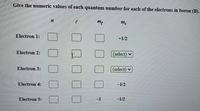
Chemistry
10th Edition
ISBN: 9781305957404
Author: Steven S. Zumdahl, Susan A. Zumdahl, Donald J. DeCoste
Publisher: Cengage Learning
expand_more
expand_more
format_list_bulleted
Question

Transcribed Image Text:Give the numeric values of each quantum number for each of the electrons in boron (B).
m,
Electron 1:
+1/2
Electron 2:
(select) v
Electron 3:
(select) v
Electron 4:
-1/2
Electron 5:
-1
-1/2
Expert Solution
This question has been solved!
Explore an expertly crafted, step-by-step solution for a thorough understanding of key concepts.
This is a popular solution
Trending nowThis is a popular solution!
Step by stepSolved in 2 steps with 2 images

Knowledge Booster
Learn more about
Need a deep-dive on the concept behind this application? Look no further. Learn more about this topic, chemistry and related others by exploring similar questions and additional content below.Similar questions
- The Pauli Exclusion Principle tells us that no two electrons in an atom can have the same four quantum numbers. y For an electron in the 2s orbital shown above, enter a possible value for each quantum number. n = 1 = Give ONE example. Give ONE example. Though a given electron only has one value for possible mi, there are my values for electrons in 2s orbitals. m = m = Submit Answer Retry Entire Group 9 more group attempts remainingarrow_forwardWhen looking at the list of electron configurations of elements up to Z = 103. Some do not follow the Aufbau principle. What do these elements have in common? A) They are all transition metals. B) They all have at least one half-filled shell. C) They all end in d5 or d10. D)They do not have anything in commonarrow_forward57 Which of the following statements is TRUE? Select one: The maximum number of electrons in the second shell (n=2) is 8. The Heisenberg Uncertainty Principle states that no two electrons can have the same mass and speed. Nitrogen has one unpaired electron. Light is a wave and never behaves as a particle. Infrared light has a higher energy than visible light.arrow_forward
- The Pauli Exclusion Principle tells us that no two electrons in an atom can have the same four quantum numbers. For an electron in the 3p orbital shown above, enter a possible value for each quantum number. n = 1 = = Give ONE example. Give ONE example. Though a given electron only has one value for possible mi, there are my values for electrons in 3p orbitals. m₁ = mg = Submit Answer Retry Entire Group 9 more group attempts remainingarrow_forwardFix any errors in these proposed electron configurations. number of electrons in atom 16 5 26 proposed electron configuration 6 15 1p 2s 2p 15²25²35²¹ 15 25 2p 3s 3p 3darrow_forwardWhich atoms or ions have the following electron configuration: 1s 2s 2p 3s-3p (select all the correct answers for full credit) O Ca2+ S2- N3- CI K+ Ararrow_forward
- Each of 5electrons in shell n= 2is assigned the following sets of quantum numbers: n, l, ml, and ms. Write the electron configuration and the orbital “box” diagram for these electrons.e1: 2, 0, 0, +½;e2; 2, 0, 0, –½;e3: 2, 1, 1, +½; e4: 2, 1, –1, +½.; e5: 2, 1, 0, +½arrow_forwardAtoms of two adjacent elements in the periodic table have a total of 40 d electrons. Atom A has no p electrons in its valence shell but atom B has one electron in the p subshell of its valence shell. Element A is_ and element B is _arrow_forwardplease solve question 1 and 2, thanks alot sirarrow_forward
arrow_back_ios
arrow_forward_ios
Recommended textbooks for you
 ChemistryChemistryISBN:9781305957404Author:Steven S. Zumdahl, Susan A. Zumdahl, Donald J. DeCostePublisher:Cengage Learning
ChemistryChemistryISBN:9781305957404Author:Steven S. Zumdahl, Susan A. Zumdahl, Donald J. DeCostePublisher:Cengage Learning ChemistryChemistryISBN:9781259911156Author:Raymond Chang Dr., Jason Overby ProfessorPublisher:McGraw-Hill Education
ChemistryChemistryISBN:9781259911156Author:Raymond Chang Dr., Jason Overby ProfessorPublisher:McGraw-Hill Education Principles of Instrumental AnalysisChemistryISBN:9781305577213Author:Douglas A. Skoog, F. James Holler, Stanley R. CrouchPublisher:Cengage Learning
Principles of Instrumental AnalysisChemistryISBN:9781305577213Author:Douglas A. Skoog, F. James Holler, Stanley R. CrouchPublisher:Cengage Learning Organic ChemistryChemistryISBN:9780078021558Author:Janice Gorzynski Smith Dr.Publisher:McGraw-Hill Education
Organic ChemistryChemistryISBN:9780078021558Author:Janice Gorzynski Smith Dr.Publisher:McGraw-Hill Education Chemistry: Principles and ReactionsChemistryISBN:9781305079373Author:William L. Masterton, Cecile N. HurleyPublisher:Cengage Learning
Chemistry: Principles and ReactionsChemistryISBN:9781305079373Author:William L. Masterton, Cecile N. HurleyPublisher:Cengage Learning Elementary Principles of Chemical Processes, Bind...ChemistryISBN:9781118431221Author:Richard M. Felder, Ronald W. Rousseau, Lisa G. BullardPublisher:WILEY
Elementary Principles of Chemical Processes, Bind...ChemistryISBN:9781118431221Author:Richard M. Felder, Ronald W. Rousseau, Lisa G. BullardPublisher:WILEY

Chemistry
Chemistry
ISBN:9781305957404
Author:Steven S. Zumdahl, Susan A. Zumdahl, Donald J. DeCoste
Publisher:Cengage Learning

Chemistry
Chemistry
ISBN:9781259911156
Author:Raymond Chang Dr., Jason Overby Professor
Publisher:McGraw-Hill Education

Principles of Instrumental Analysis
Chemistry
ISBN:9781305577213
Author:Douglas A. Skoog, F. James Holler, Stanley R. Crouch
Publisher:Cengage Learning

Organic Chemistry
Chemistry
ISBN:9780078021558
Author:Janice Gorzynski Smith Dr.
Publisher:McGraw-Hill Education

Chemistry: Principles and Reactions
Chemistry
ISBN:9781305079373
Author:William L. Masterton, Cecile N. Hurley
Publisher:Cengage Learning

Elementary Principles of Chemical Processes, Bind...
Chemistry
ISBN:9781118431221
Author:Richard M. Felder, Ronald W. Rousseau, Lisa G. Bullard
Publisher:WILEY